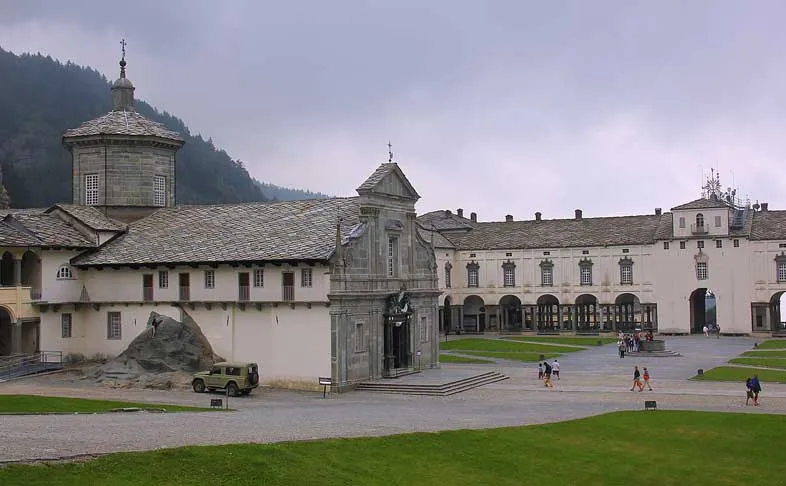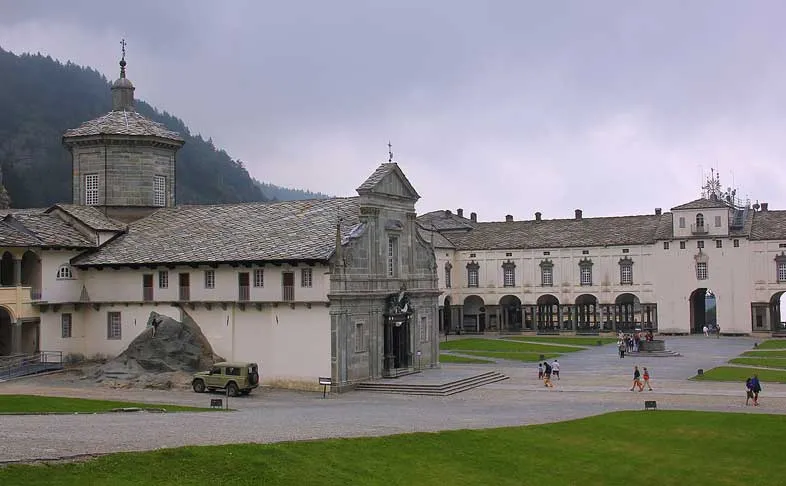
Introduction
The Sanctuary of Oropa (Italian: santuario di Oropa) is a group of Roman Catholic buildings and structures in Oropa, frazione of the municipality of Biella, Italy. It is located at a height of 1,159 metres in a small valley of the Alpi Biellesi.
Pope Francis granted an official decree of Pontifical coronation to the image of “Madonna Della Oropa” on 5 August 2021, signed and executed by the Dean of the College of Cardinals, Giovanni Battista Re at the Vatican.
The Oropa Sanctuary, located at 1200 m altitude, is the most im‐ portant Marian Sanctuary of the Alps: it’s surrounded by a breath‐ taking natural landscape at only 20 minutes drive from the centre of Biella.
According to tradition, the origin of the Oropa Sanctuary dates back to the 4th century AD., when it was erected by St. Eusebio, the first Archbishop of Vercelli. The oldest documents, dating back to 1200, mention the sacellum where the Black Virgin was worshipped.
The current Basilica (beginning of 1600) was erected around this small chapel, as was the rest of the impressive building complex, including the Upper Basilica that was consecrated in 1960. Famous architects like Filippo Juvarra, Guarino Guarini, Filippo Beltrame, Ignazio A. Galletti, Pierpaolo Bonora contributed to designing and developing the group of buildings which make up the Sanctuary.
History of Sanctuary of Oropa, Biella
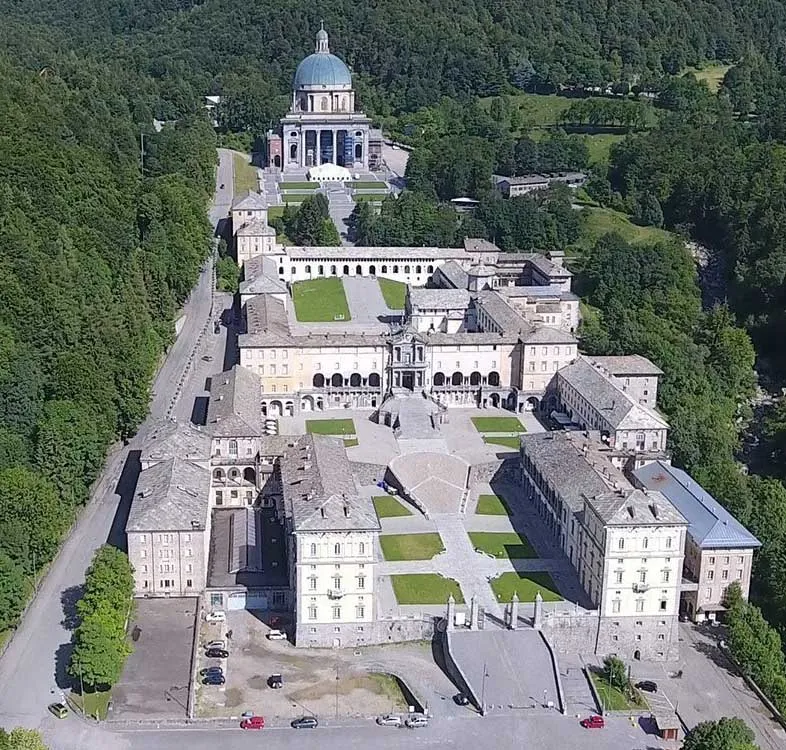
According to legend, a black wooden statue of the Virgin Mary carved by Saint Luke was found in Jerusalem by Saint Eusebius of Vercelli, carried to Oropa in the 4th century AD and placed into a small niche in a big boulder. In the Middle Ages, a church was built around the niche housing the statue, and was replaced in the early 17th century with what is known today as the Ancient Basilica.
During the following two centuries, several other buildings were added to the complex, including the royal apartments of the House of Savoy, a big library and the Royal Gate, a masterpiece designed by the architect Filippo Juvarra in the 18th century.
The last addition to the sanctuary was the Upper Basilica, a monumental church built between 1885 and 1960 due to the large number of pilgrims visiting Oropa. It can hold 3000 people and its dome is 80 metres high.
In 1617, the complex of the Sacro Monte di Oropa (literally Sacred Mount of Oropa) was built not far from the sanctuary. It is a devotional path now composed of twelve chapels (plus another seven nearby) containing groups of statues representing scenes from the story of the Virgin Mary’s life.
A new graveyard was built near the Sacro Monte in the 19th century, for noble families of the Biellese territory to build their family tombs. Some graves have freemason symbols, such as Quintino Sella’s.
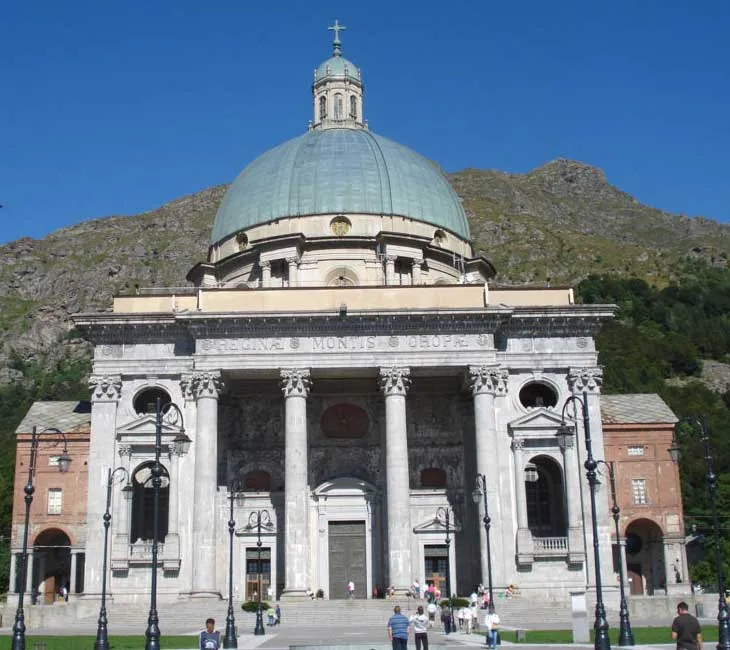
Architecture
Oropa offers a unique artistic and cultural heritage. A few examples: the 18th century royal door created by Juvarra, the historical library which counts a great number of ancient volumes, the two galleries dedicated to votive offerings, the Savoy Royal Pavilion and the Museum, with its collection of jewels and vestments and where the history of the Sanctuary is preserved.
A visit to the Sacred Mount is also worthwhile. It is formed by 12 chapels dedicated to the life of the Holy Virgin which are surrounded by hundreds of polychromatic statues, sculpted from 1620 to 1720. It has recently been included among the UNESCO World Heritage sites. On the left side of the Sacred Mount you can find the Monumental Cemetery, where stands out the pyramid tomb of the statesman Quintino Sella.
Black Madonna of Oropa (Our Lady of Oropa)
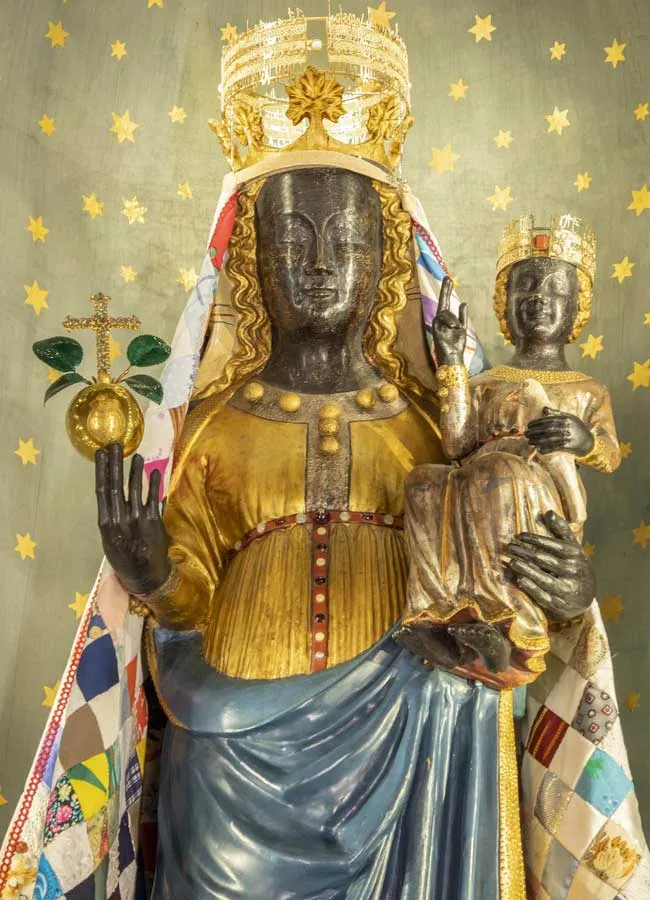
The Black Madonna of Oropa (Madonna Della Oropa) also known as Black Virgin of Oropa is a darkened wood pigmented statue of the Madonna and Child.
Our Lady of Oropa, near Bielle, in Savoy; this image, of cedar wood, six feet high, is in a chapel which Saint Eusebius, Bishop of Bercelli, caused to be built, about the year 380; he often retired thither during the troubles caused by the Arians.
The sanctuary of the black Virgin of Oropa, high in the Alps north of Biella, is traditionally associated with Saint Eusebius of Vercelli, who died in 371; but the circumstances of the story are anachronistic. Yet the shrine is certainly an old one, and throughout the Middle Ages was associated with a Community of Canon Regulars.
The vast range of buildings there today were begun by the dukes of Savoy, early in the seventeenth century, and form one of the most complete pilgrimage centers in the world (there is even a cinema theater). It is recorded that here in 1895, contemplating the space and beauty of the mountains, Marconi heard the first call to his life’s work.
The black painted cedar-wood statue has been crowned four times, the last time in 1920; the three superimposed diadems (the fourth is represented by a halo of twelve stars) can hardly be said to add to the beauty of the image.
The image was brought by Saint Eusebius of Vercelli from the Middle East, presumably from Syria or Lebanon to his diocese of Vercelli. During a mid-fourth century persecution of Christians by the local Celtic pagans, Eusebius retreated to the mountains of Sacro Monte di Oropa, about 9 miles from Biella, Italy and hid the statue of the Madonna in a cave.
When they later tried to move the image, its weight was supernaturally increased and they had to leave it there, in the mountains, where it currently presides over a massive shrine. Pious believers interpret the supernatural weight of the image to be a sign from the Blessed Virgin Mary that she willed a sanctuary be built there.
Local legends further claim that before the arrival of Eusebius, the Celtic tribes worshipped a black fertility god which was allegedly replaced by the present Madonna and Child image.
The Black Virgin is also known as Madonna Nera di Oropa or María Reina de Monte Oropa, and she is the patroness of Lomas del Mirador City, in La Matanza Partido, Buenos Aires Province, Argentina.
History of Our Lady of Oropa
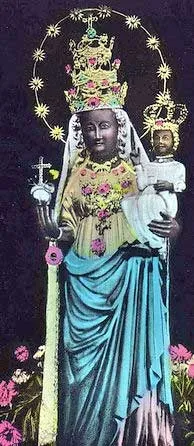
The image, of cedar of Lebanon, with face and hands painted black, and decorated with gold and gemstones. It “is a refined masterpiece by a sculptor from Valle d’Aosta dating back to the late thirteenth century.” The statue is housed in the Old Basilica.
The following was submitted by Stefano Prior from Biella, Italy: A great sign appeared in the sky, a woman clothed with the sun, with the moon under her feet, and on her head a crown of twelve stars. She was with child and wailed aloud in pain as she labored to give birth.
Our lady of Oropa represents completely and uniquely the Woman of the Apocalypse.
She’s pregnant and the Baby Jesus is already there. She is clothed with gold (sun). There is a little be more to be known about this location: Oropa is on top of the regional road number 144 and connected to another, unique, Sanctuary dedicated to the Baptist, with a local road numbered 513 (day of Fatima).
The venerated Marian image was first episcopally crowned by Bishop Giacomo Goria on 30 August 1620. The event is commemorated every 100 years since 1620 with a coronation held on the last Sunday of August. It was postponed for a year in 2020 due to the pandemic. Pope Francis granted an official decree of Pontifical coronation to the image on 5 August 2021, signed and executed by the Dean of the College of Cardinals, Giovanni Battista Re at the Vatican. The coronation was officially carried out on 29 August 2021.
Ancient Basilica
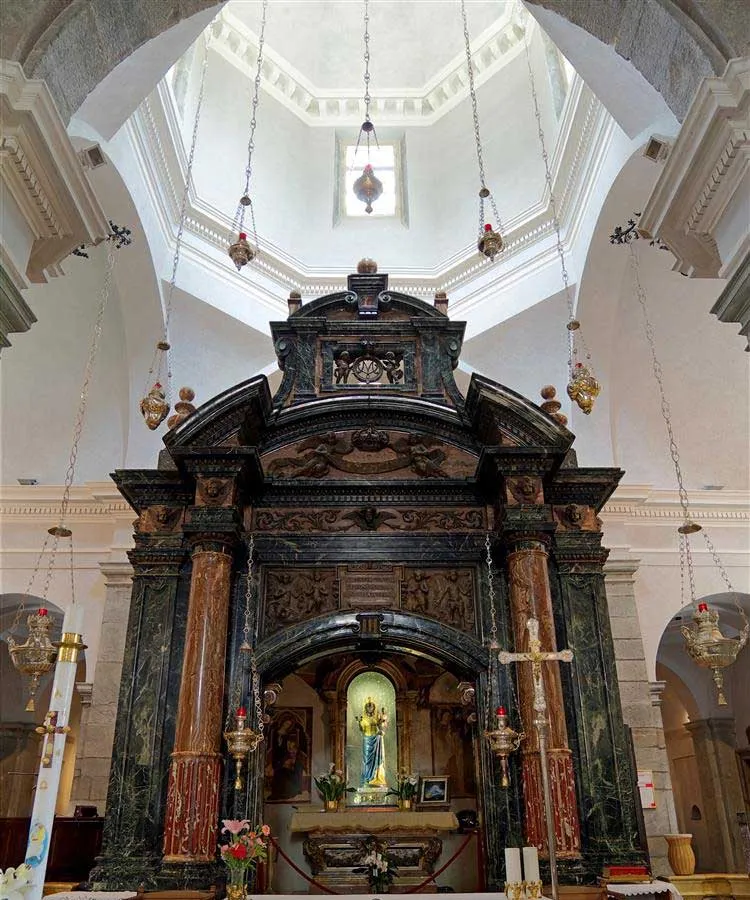
The spiritual heart of the Sanctuary, the Ancient Basilica was built in the seventeenth century, following the vow made by the City of Biella on the occasion of the plague epidemic of 1599. In 1620, with the completion of the Church, the first of the solemn coronations was held every hundred years have marked the history of the Sanctuary.
The facade, designed by the architect Francesco Conti, simple in the elegance of the greenish veins of the Oropa stone, is ennobled by the darker portal which bears the Savoy coat of arms of Duke Carlo Emanuele II at the top, supported by two stone angels. The inscription “O quam beatus, o Beata, quem viderint oculi tui” is carved on the architrave of the portal. XVII is the greeting that the pilgrim, having reached his destination, receives as he crosses the threshold of the Basilica.
Raised on the site where the ancient church of Santa Maria once stood, it preserves inside, like a precious casket, the Eusebian Sacellum, built in the 9th century. Precious frescoes dating back to the 14th century, the work of an unknown painter, known as the Maestro di Oropa, are visible in the cap and in the internal walls of the Sacellum.
The cycle of frescoes, centered on the Virgin and some saints who must have been particularly venerated in the ancient hermitage, constitutes a precious testimony of sacred iconography. The statue of the Black Madonna is kept inside the chapel, made of pine wood by the chisel of a Aosta Valley sculptor in the XIII century. The blue mantle, the dress and the gold-colored hair frame the face painted in black, whose sweet and austere smile has welcomed pilgrims over the centuries.
According to tradition, the statue was brought by St. Eusebius from Palestine in the 4th century AD while he was fleeing the fury of the Aryan persecution; working to spread Marian devotion, Sant’Eusebio would have hidden the statue among the rocks where the Cappella del Roc now stands, built in the first half of the eighteenth century by the inhabitants of Fontainemore, a locality in the Aosta Valley still today strongly linked to the Sanctuary by the ancient procession that it winds its way every five years between the mountains that separate the two valleys.
During the restoration work carried out in the first months of 2005, decorations dating back to the 17th century emerged on the vault, characterized by yellow ocher floral motifs on a blue field, a recent discovery of a past that still has mysteries to reveal.
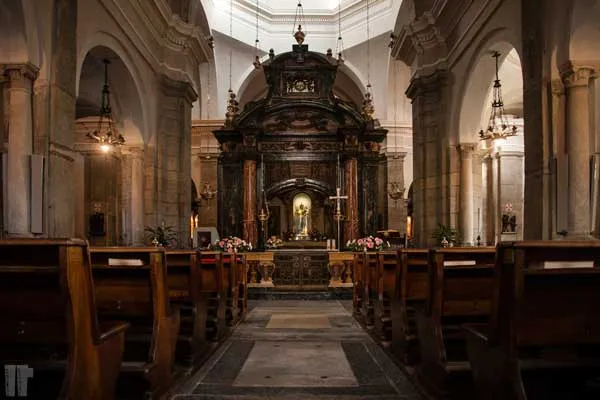
Devotion and Popular Beliefs
The statue of the black Madonna has always been venerated; several miracles and protections are attributed to the Virgin of Oropa. Blessed Pier Giorgio Frassati was known for his devotion to the Black Madonna of Oropa.
During the centuries, people made ex-voto (for grace) pictures to thank the Virgin Mary. All of these pictures are still preserved in the sanctuary in the ‘ex voto gallery’. The oldest picture dates back to 1522 and was made by painter Bernardino Lanino.
The popular belief says that the wooden statue has some peculiar characteristics:
- Despite the age of the statue it has no woodworm;
- The foot, despite the ancient tradition of touching it for good luck, is not worn out;
- Dust does not settle on the faces of the Virgin and of the Baby.
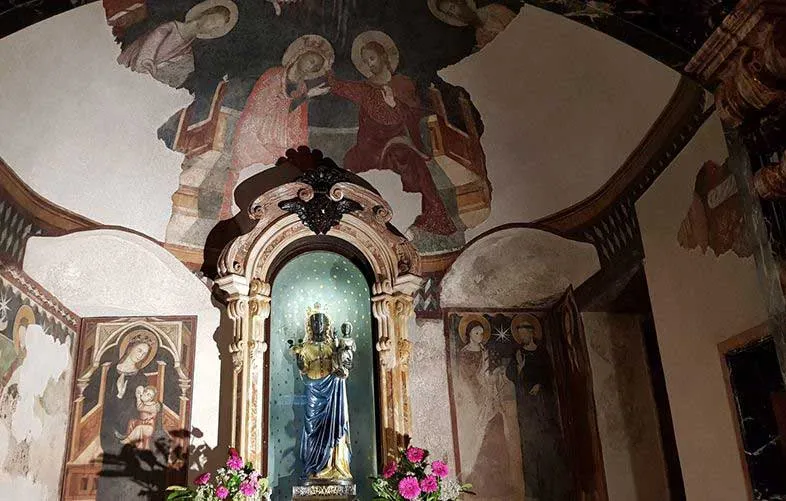
Pilgrimages
Around 800,000 pilgrims and one-hundred pilgrimages visit the sanctuary each year. According to the popular tradition, the town of Biella made a vow during the 17th century plague and its inhabitants were spared by the infection.
Following this grace, the town does a pilgrimage every year to the sanctuary in order to thank the Virgin Mary. The evocative and ancient pilgrimage from Fontainemore to Oropa takes place every five years.
Nature Conservation
The mountain area surrounding the sanctuary is included in a regional park of 1,518.28 hectacre named Riserva Naturale Speciale del Sacro Monte di Oropa.
The Historical Archive of the Sanctuary of Oropa
The history of the Sanctuary of Oropa is preserved in its Historical Archive, a set of documentary and iconographic testimonies of considerable cultural importance. The Historical Archive of the Sanctuary of Oropa preserves documents produced between the sixteenth century and around 2000. More than one hundred linear meters of ancient papers, over thirty thousand photographic images and some films document the life of Oropa both in a devotional sense and for all the administrative, economic and social aspects of an articulated and complex “universe”.
Oropa was not and is not “only” the great Shrine of the Black Madonna, but it is also one of the fundamental elements in the history of the Biella area (and beyond): the Historical Archive faithfully reflects Oropa’s preeminent role in the Marian cult and in local and non-local history.
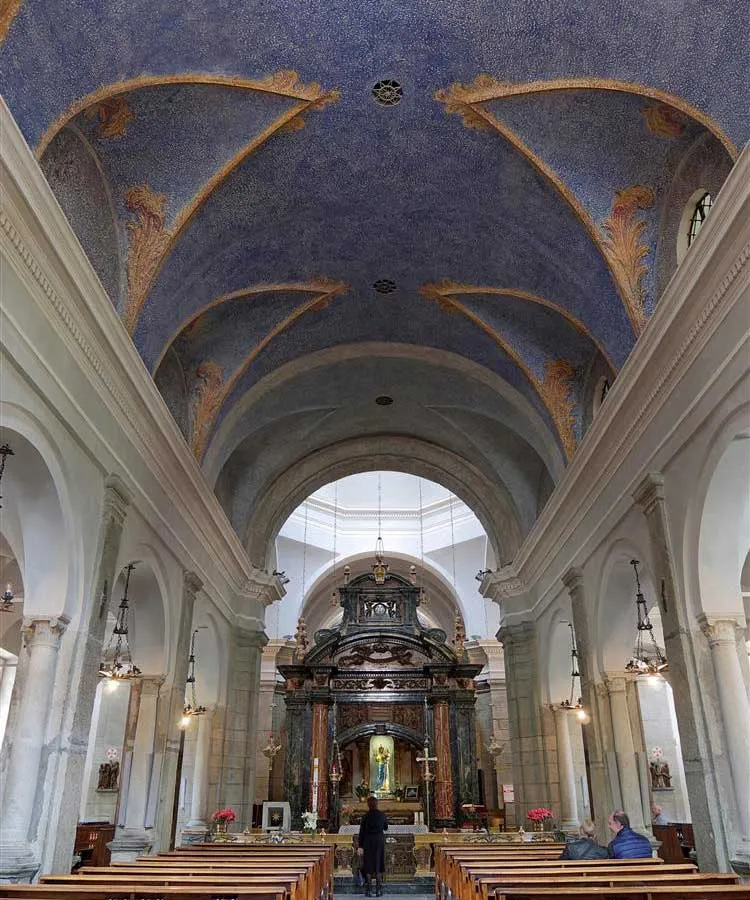
The Historic Library of the Sanctuary
The Oropa Sanctuary Library was established starting in the 17th century with the volumes of religious themes used and then left in Oropa by the collegial priests active in the Sanctuary. In the eighteenth century it was enriched with other book collections donated by religious and lay devotees, while in the nineteenth century a large part of the library of the Augustinian convent of San Pietro di Biella was acquired, suppressed in the Napoleonic era.
To this set belong some incunabula, various sixteenth-century texts and many texts of a religious nature from the seventeenth and eighteenth centuries, including the Biblia polyglotta printed in Nuremberg in 1657 which contains the Holy Scriptures translated into seven ancient languages, from Hebrew to Samaritan, from Chaldean to Persian.
The “admissions” of recent years have instead considerably increased the number of books relating to the Biella area (with an all oropense section) and to Piedmont in general. Currently the Oropa Sanctuary Library has over 15,000 volumes.
The Historical Archive and the Oropa Library are accessible for consultation upon reservation by contacting the Administration of the Sanctuary of Oropa. The regulations for use of the Historical Archive are available on the specific page.
Feast Day - 29th October
Annual Feast Day of Our Lady of Oropa held on 29th October.
Mass Time
Weekdays
Sundays
Church Visiting Time
Contact Info
Via Santuario D’Oropa, 480,
13900, Oropa, Biella, Italy
Phone No.
Tel : +39 015 25 551 200
Accommodations
How to reach the Sanctuary
Milan Malpensa Airport is the largest international airport in northern Italy, is 49 kilometres northwest of Milan, next to the Ticino river dividing Lombardy and Piedmont is the nearby Airport to the Sanctuary.
Biella San Paolo Railway Station in Biella, Italy is the nearby Train Station to the Sanctuary.

